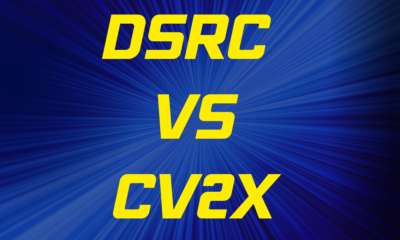Business Solutions
Security of VMS Solutions with Intelligent Video Analytics
In an era where security is paramount, Video Management Systems (VMS) are evolving rapidly, integrating advanced technologies to enhance surveillance capabilities. One of the most significant advancements is the incorporation of Intelligent Video Analytics (IVA). This technology not only improves the accuracy and efficiency of monitoring but also fortifies the security framework of VMS solutions. By leveraging IVA, organizations can automatically detect and analyze events in real-time, reducing the need for constant human oversight and enabling quicker, more effective responses to potential threats. This blog explores how Intelligent Video Analytics is transforming the security landscape of VMS solutions, making them more robust and reliable.
Published
9 months agoon
By
Marks Strand
Video Management Systems (VMS) and Intelligent Video Analytics (IVA) are at the forefront of transforming modern surveillance. By integrating VMS solutions with intelligent video analytics, organizations can achieve unprecedented levels of security and operational efficiency. This synergy enhances the capabilities of traditional video surveillance by incorporating advanced analytical tools, which allow for real-time monitoring, automated responses, and insightful data analysis.
As technology evolves, the need for sophisticated surveillance solutions grows. VMS solutions provide a robust platform for managing video feeds, while intelligent video analytics add a layer of advanced data processing. Together, they create a powerful system capable of handling complex security needs and improving overall operational effectiveness.
History of Video Management Systems (VMS)
Video Management Systems have come a long way since their inception. Initially, VMS solutions were designed to handle basic recording and playback functions. However, as security needs have become more complex, VMS technology has evolved to include a range of advanced features.
Early VMS solutions focused primarily on video recording and retrieval. These systems were often limited in their capabilities, offering only basic storage options and manual controls. As technology progressed, so did the functionality of VMS solutions. Modern systems now support advanced features such as high-definition video recording, cloud storage, and remote access.
One significant milestone in VMS development was the introduction of network-based video management. This allowed for the integration of multiple cameras and sensors into a single system, providing a comprehensive view of security operations. Today’s VMS solutions offer enhanced scalability, allowing organizations to expand their systems seamlessly as their needs grow.
Unveiling Intelligent Video Analytics (IVA)
Intelligent Video Analytics (IVA) represents a significant advancement over traditional video analytics. Unlike conventional systems that rely on basic motion detection and object tracking, IVA leverages artificial intelligence and machine learning to provide deeper insights from video feeds.
IVA technology is designed to process and analyze video data in real-time, identifying patterns and anomalies that would be difficult for human operators to detect. This includes advanced capabilities such as facial recognition, license plate reading, and behavior analysis. By utilizing these technologies, IVA enhances the accuracy and efficiency of video surveillance systems.
One of the key advantages of IVA is its ability to perform real-time analysis. This means that security alerts and operational insights can be generated immediately, allowing for quicker responses to potential threats. For instance, IVA can identify unusual behavior patterns and send instant alerts to security personnel, enabling them to take timely action.

Seamless Integration: VMS and IVA in Harmony
The integration of VMS solutions with IVA technology offers a range of benefits, creating a more cohesive and effective surveillance system. This integration allows for the seamless flow of data between video management and analytics platforms, enhancing system performance and accuracy.
Integrated VMS and IVA systems work together to provide a comprehensive view of security operations. VMS solutions manage the video feeds, while IVA processes the data to extract valuable insights. This synergy improves the overall functionality of the surveillance system, enabling features such as real-time threat detection and automated response actions.
For example, a VMS equipped with IVA capabilities can automatically identify and track suspicious activities across multiple camera feeds. This integrated approach ensures that all relevant data is captured and analyzed, providing a more complete and actionable picture of security events.
Cutting-Edge Features of Modern VMS Solutions
Modern VMS solutions are equipped with a range of advanced features designed to enhance security and operational efficiency. These features include:
- High-Definition Video Recording: Modern VMS solutions support high-definition video recording, providing clear and detailed footage that can be crucial for identifying and investigating incidents.
- Cloud-Based Storage: Cloud-based storage options allow for scalable and secure video data management. This ensures that video footage is easily accessible and protected against data loss.
- Remote Access: Remote access capabilities enable users to view and manage video feeds from any location. This is particularly useful for organizations with multiple sites or remote operations.
In addition to these features, modern VMS solutions offer enhanced scalability, allowing organizations to expand their surveillance systems as needed. This flexibility ensures that the system can adapt to changing security requirements and technological advancements.
Leveraging IVA for Proactive Security Measures
Intelligent Video Analytics (IVA) plays a crucial role in enhancing proactive security measures. By analyzing video data in real-time, IVA can detect potential threats and anomalies before they escalate into serious incidents.
One of the key benefits of IVA is its ability to perform behavioral analysis. This involves monitoring video feeds for unusual behavior patterns that may indicate a security threat. For example, IVA can identify individuals loitering in restricted areas or vehicles entering secure zones without authorization. These alerts can be used to prompt immediate action, such as notifying security personnel or activating additional surveillance measures.
Another important application of IVA is its role in reducing false alarms. Traditional video analytics systems often generate numerous false alerts due to factors such as weather conditions or passing animals. IVA technology, with its advanced algorithms and machine learning capabilities, is designed to minimize false alarms by accurately distinguishing between genuine threats and benign events.
Optimizing Operational Efficiency with VMS and IVA
The integration of VMS solutions with IVA technology offers significant improvements in operational efficiency. By automating video analysis and streamlining data management, organizations can reduce manual oversight and improve response times.
Automated video analysis provided by IVA eliminates the need for constant human monitoring of video feeds. This not only reduces the workload for security personnel but also ensures that potential threats are detected and addressed in real-time. Additionally, the ability to analyze large volumes of video data quickly and accurately improves overall efficiency.
The use of VMS and IVA also enhances the quality of security operations by providing detailed insights and reports. These reports can be used to identify trends, assess the effectiveness of security measures, and make informed decisions about future investments in surveillance technology.
Addressing Common Challenges in VMS and IVA Deployment
While VMS and IVA technologies offer numerous benefits, there are also several challenges associated with their deployment. Common issues include integration with legacy systems, scalability concerns, and technical complexities.
Integration with legacy systems can be a significant challenge, as older equipment may not be compatible with modern VMS and IVA solutions. Addressing this issue often involves upgrading or replacing outdated hardware and software. Additionally, ensuring compatibility between different systems and technologies requires careful planning and technical expertise.
Scalability is another important consideration, particularly for organizations with large or growing surveillance needs. Modern VMS solutions and IVA technologies are designed to be scalable, but it is essential to plan for future expansion and ensure that the system can accommodate increased data volumes and additional cameras.
Future Innovations in VMS and IVA Technologies
The field of video management and analytics is constantly evolving, with new innovations and technologies emerging regularly. Future advancements in VMS and IVA are expected to include enhancements such as edge computing, AI-driven analytics, and improved cloud integration.
Edge computing, for example, involves processing video data closer to the source, reducing latency and improving real-time analysis. This technology is expected to enhance the performance of VMS and IVA systems by enabling faster data processing and response times.
AI-driven analytics are also poised to play a significant role in the future of surveillance technology. Advances in artificial intelligence will continue to improve the accuracy and capabilities of IVA systems, enabling even more sophisticated data analysis and threat detection.
Maximizing the Potential of VMS and IVA
The integration of Video Management Systems (VMS) with Intelligent Video Analytics (IVA) offers a powerful solution for modern surveillance needs. By leveraging the strengths of both technologies, organizations can achieve enhanced security, improved operational efficiency, and valuable insights from their video data.
To maximize the benefits of VMS and IVA, businesses should focus on selecting solutions that offer scalability, ease of integration, and advanced analytical capabilities. Strategic implementation and ongoing management of these technologies will ensure that organizations are well-equipped to handle evolving security challenges and maintain effective surveillance operations.
By embracing the latest innovations in VMS and IVA, organizations can stay ahead of potential threats and optimize their security measures, ultimately creating a safer and more efficient environment.
FAQs
- What are VMS solutions and how do they work?
VMS solutions, or Video Management Systems, are platforms designed to manage and record video feeds from surveillance cameras. They provide functionalities such as video storage, playback, and remote access, enabling users to monitor security footage in real-time and archive it for future reference.
- How does Intelligent Video Analytics (IVA) enhance surveillance?
Intelligent Video Analytics (IVA) enhances surveillance by utilizing advanced algorithms and machine learning to analyze video data in real-time. IVA can detect patterns, recognize objects, and identify anomalies that traditional video analytics might miss, leading to more accurate and timely security alerts.
- What are the key benefits of integrating VMS with IVA?
Integrating VMS with IVA provides a comprehensive surveillance solution that combines video management with advanced data analysis. This integration allows for real-time threat detection, automated responses, and detailed insights, improving overall security and operational efficiency.
- What features should modern VMS solutions include?
Modern VMS solutions should include features such as high-definition video recording, cloud-based storage, remote access capabilities, and scalability. These features ensure clear video footage, secure data management, and the ability to expand the system as needed.
- How does IVA contribute to reducing false alarms?
IVA contributes to reducing false alarms by using advanced algorithms to differentiate between genuine threats and benign events. This technology minimizes the occurrence of false positives, resulting in more accurate alerts and less frequent unnecessary responses.
- What are some common challenges in deploying VMS and IVA technologies?
Common challenges in deploying VMS and IVA technologies include integrating with legacy systems, addressing scalability concerns, and managing technical complexities. Overcoming these challenges often involves upgrading equipment, planning for future expansion, and ensuring compatibility between different technologies.
- How can organizations optimize operational efficiency with VMS and IVA?
Organizations can optimize operational efficiency by automating video analysis with IVA, which reduces the need for constant manual monitoring. Additionally, detailed insights and reports from these technologies help organizations make informed decisions and streamline their security operations.
- What role does edge computing play in the future of VMS and IVA?
Edge computing involves processing video data closer to the source, which reduces latency and improves real-time analysis. This technology is expected to enhance the performance of VMS and IVA systems by enabling faster data processing and quicker response times.
- How do AI-driven analytics impact the future of surveillance technology?
AI-driven analytics will significantly impact the future of surveillance technology by enhancing the accuracy and capabilities of IVA systems. Advances in artificial intelligence will enable even more sophisticated data analysis, threat detection, and automated responses.
- What should organizations consider when selecting VMS and IVA solutions?
Organizations should consider factors such as scalability, ease of integration, advanced analytical capabilities, and the ability to meet future security needs when selecting VMS and IVA solutions. Ensuring these factors will help organizations effectively manage their surveillance operations and respond to evolving security challenges.
You may like
Business Solutions
Geneo Glam: Skin Firming Treatment for Radiant, Youthful Skin
Geneo Glam is the ultimate skin firming treatment designed to restore elasticity, enhance radiance, and leave you with a glowing, youthful complexion.
Published
12 hours agoon
May 9, 2025By
Marks Strand
The Geneo Glam skin firming treatment is a luxurious, non-invasive facial that revitalizes the skin by improving firmness, elasticity, and hydration. Using advanced OxyPod technology, this treatment delivers a unique combination of exfoliation, oxygenation, and infusion of active ingredients to help the skin look smoother, tighter, and more radiant.
Key Benefits
- Firms and Hydrates
The treatment boosts collagen and elastin production, helping skin feel firmer and more supple. - Improves Elasticity
Increases the skin’s resilience and reduces the appearance of fine lines and wrinkles. - Prevents Collagen Breakdown
Helps preserve the skin’s youthful structure by protecting existing collagen and supporting healthy cell function.
Powerful Natural Ingredients
- 24K Gold Particles
Stimulate collagen production, protect skin fibers, and encourage cell renewal for a firmer, lifted appearance. - Silk Amino Acids
Strengthen the skin barrier, lock in moisture, and support collagen synthesis to reduce visible signs of aging. - Carnosine Peptides
Help protect the skin from sugar-related damage (glycation), delay cellular aging, and extend the life of skin cells. - Copper
An antioxidant and anti-inflammatory that supports collagen development, smooths fine lines, and helps with skin regeneration.
How the Treatment Works
- Exfoliation and Oxygenation
The Geneo Glam OxyPod is activated with a Primer Gel, gently exfoliating the skin and triggering a natural oxygenation process that increases blood flow and enhances skin vitality. - Infusion of Actives
Active ingredients such as gold particles, peptides, and amino acids are infused deep into the skin to firm and rejuvenate. - Hydration and Nourishment
A final serum containing hyaluronic acid, rosehip oil, and marula oil hydrates and soothes the skin, leaving it soft and glowing.
Who Should Try Geneo Glam?
This treatment is ideal for people who want to:
- Reduce fine lines and early signs of aging
- Firm and tighten sagging skin
- Restore hydration and improve skin tone
Geneo Glam offers a refreshing way to firm, lift, and hydrate your skin—leaving you with a youthful glow and smooth, resilient skin. It’s a perfect solution for anyone seeking visible results without invasive procedures or downtime.
Business Solutions
H.265 miniature UAV encoders: A comprehensive Overview
H.265 miniature UAV encoders revolutionize aerial technology with advanced video compression, ensuring high efficiency and superior performance for modern UAV systems.
Published
2 days agoon
May 8, 2025By
Adva
As the demand for high-quality, real-time video transmission from unmanned aerial vehicles (UAVs) continues to rise in both military and commercial applications, the need for efficient, compact video encoding solutions has become paramount. H.265 miniature UAV encoders represent a significant advancement in this space, providing robust video compression in a small, lightweight package ideal for drones with stringent size, weight, and power (SWaP) constraints. Leveraging the power of High Efficiency Video Coding (HEVC), also known as H.265, these encoders allow UAVs to deliver high-resolution video over constrained data links, enhancing situational awareness and operational effectiveness without overwhelming available bandwidth.
H.265 is a video compression standard that succeeds H.264/AVC and offers approximately double the data compression ratio at the same video quality level. This efficiency is particularly beneficial for UAV applications, where bandwidth and power availability are limited, especially during beyond-line-of-sight (BLOS) missions or in contested environments. With H.265 encoders, UAVs can stream 1080p or even 4K encoder video in real time while consuming significantly less data than older standards. This is critical for operations such as intelligence, surveillance, and reconnaissance (ISR), where maintaining video clarity over long distances or through relay networks is essential for accurate decision-making.
Miniature H.265 UAV encoders are engineered to operate under harsh environmental conditions while maintaining optimal performance. These devices are typically ruggedized, featuring extended temperature ranges, shock resistance, and electromagnetic shielding to ensure reliable operation in military or field environments. Despite their small size—often no larger than a deck of cards—they include advanced features such as low-latency encoding, dynamic bitrate control, encryption, and support for multiple streaming protocols including RTSP, RTP, and MPEG-TS. This allows them to integrate seamlessly into existing command-and-control infrastructure and support a variety of end-user applications, from real-time ground monitoring to autonomous navigation and object tracking.

The integration of H.265 encoders into small UAVs has significantly expanded the capability of tactical drone systems. For example, military units can deploy hand-launched drones equipped with these encoders to provide persistent ISR coverage over a battlefield, transmitting clear, actionable video intelligence back to command centers in near real time. Law enforcement agencies and border security forces also benefit from these technologies, using UAVs to monitor large or remote areas with minimal personnel. In disaster response scenarios, such encoders enable drones to deliver live aerial assessments of affected regions, helping responders prioritize actions and coordinate relief efforts efficiently.
Beyond video transmission, modern H.265 UAV encoders are increasingly integrated with onboard artificial intelligence modules that enable edge processing. This allows UAVs to perform real-time object recognition, motion detection, and scene analysis directly within the encoder, reducing the need to send raw data to centralized systems for processing. Such capabilities are crucial in time-sensitive missions where latency can affect outcomes, such as tracking moving targets or identifying threats in complex terrain.
Despite their many advantages, the deployment of H.265 miniature encoders does come with some technical considerations. The encoding process, while more efficient than previous standards, requires higher computational resources. Manufacturers must therefore strike a careful balance between processing power, thermal management, and energy consumption. Additionally, the compatibility of H.265 streams with legacy systems remains a factor, as not all ground stations or video players natively support HEVC decoding without updates or specialized software.
Manufacturers of H.265 miniature UAV encoders include companies such as IMT Vislink, Soliton Systems, Haivision, and VITEC, all of which provide solutions tailored to UAV and robotics applications. These encoders are often modular, allowing integrators to select configurations based on mission requirements, payload limitations, and transmission needs. As the ecosystem of compact, high-efficiency video systems grows, continued innovation in low-power silicon and AI integration is expected to drive the next wave of capability enhancements in this field.
In the evolving landscape of drone technology, H.265 miniature UAV encoders stand out as a critical enabler of high-performance video transmission. By combining advanced compression with minimal SWaP impact, these systems provide UAV operators with the tools to observe, analyze, and act with unprecedented precision and clarity—no matter how small the platform or how demanding the environment.
Business Solutions
IEEE 802.11p and V2X Communication: Enabling Smarter, Safer Roads
IEEE 802.11p revolutionizes V2X communication, driving smarter, safer roads through advanced vehicle connectivity. This cutting-edge technology enhances transportation systems, enabling intelligent and secure interactions for a safer future.
Published
2 days agoon
May 7, 2025By
Adva
Modern vehicles are no longer isolated machines; they are becoming intelligent, connected nodes within a larger transportation ecosystem. At the heart of this transformation is Vehicle-to-Everything (V2X) communication, which enables cars to talk to each other and to the infrastructure around them. One of the first and most influential technologies developed to support V2X is the IEEE 802.11p standard—a wireless standard specifically tailored for vehicular environments.
What is IEEE 802.11p?
IEEE 802.11p is an amendment to the IEEE 802.11 standard (commonly known as Wi-Fi), designed to enable wireless access in vehicular environments. It was approved in 2010 and forms the basis for Dedicated Short-Range Communications (DSRC).
Key Characteristics of 802.11p:
- Frequency Band: Operates in the 5.9 GHz band reserved for Intelligent Transportation Systems (ITS).
- Low Latency: Optimized for fast, real-time communication necessary for safety-critical applications.
- Range: Effective communication range of up to 1 kilometer, suitable for high-speed vehicle interaction.
- Decentralized Architecture: Enables direct communication (V2V and V2I) without the need for cellular or network infrastructure.
- Robustness: Handles high-speed mobility and rapidly changing topologies typical of vehicular environments.

Role of 802.11p in V2X Communication
V2X (Vehicle-to-Everything) is a broader term encompassing various communication paradigms, including:
- V2V (Vehicle-to-Vehicle)
- V2I (Vehicle-to-Infrastructure)
- V2P (Vehicle-to-Pedestrian)
- V2N (Vehicle-to-Network)
- V2C (Vehicle-to-Cloud)
802.11p primarily supports V2V and V2I communications, forming the backbone of DSRC-based V2X implementations. Its low latency and direct communication capabilities make it ideal for applications such as:
- Forward collision warnings
- Intersection movement assist
- Emergency electronic brake lights
- Lane change warnings
Comparison with Cellular V2X (C-V2X)
As V2X technology has evolved, C-V2X (based on LTE and 5G standards) has emerged as a strong alternative to 802.11p. Here’s how they compare:
| Feature | IEEE 802.11p (DSRC) | C-V2X (LTE/5G) |
| Latency | ~10 ms | ~5–10 ms (LTE), <5 ms (5G) |
| Coverage | Short-range, direct | Short + long-range via network |
| Deployment | Mature, field-tested | Growing, especially with 5G |
| Infrastructure | Minimal (no cellular needed) | Requires cellular networks (for V2N/V2C) |
| Interoperability | Limited with C-V2X | Newer versions support dual-mode |
Adoption and Use Cases
Global Deployment:
- United States: Initially favored DSRC based on 802.11p, though recent FCC rulings have shifted focus toward C-V2X.
- Europe: ETSI has defined ITS-G5, a protocol stack based on 802.11p.
- Japan and South Korea: Active use of DSRC for tolling and traffic safety.
Real-World Applications:
- Collision avoidance systems
- Smart intersections
- Road hazard notifications
- Platooning for commercial vehicles
- Public transport priority systems
Advantages of 802.11p
- Mature and Proven: Used in numerous pilot programs and early deployments.
- Fast Time to Communication: No need for handshake protocols; devices can communicate almost instantly.
- No Subscription Costs: Operates independently of cellular networks.
Limitations and Challenges
- Scalability: In high-density traffic, packet collisions may reduce reliability.
- Spectrum Allocation: Regulatory changes in some countries have limited the bandwidth available to DSRC.
- Limited Ecosystem Growth: Many automakers and countries are shifting investment to C-V2X and 5G-based platforms.
Future Outlook
While 802.11p has laid the foundation for V2X communication, the industry is gradually pivoting toward more advanced and scalable technologies such as 5G NR-V2X. However, 802.11p remains relevant in regions where DSRC infrastructure is already deployed and continues to serve as a dependable option for immediate, low-latency vehicular communication.
Hybrid Solutions:
Some industry players are exploring dual-mode V2X devices that support both 802.11p and C-V2X, ensuring backward compatibility and smoother transitions.
IEEE 802.11p has played a pivotal role in launching the era of connected vehicles, offering reliable, low-latency communication tailored for high-speed mobility. While newer technologies like C-V2X and 5G are beginning to dominate the roadmap, 802.11p’s contributions remain foundational in the evolution of V2X systems. As the automotive industry moves forward, a mix of technologies, including legacy support for 802.11p, will ensure that safety, efficiency, and connectivity continue to advance on roads around the world.

Geneo Glam: Skin Firming Treatment for Radiant, Youthful Skin

H.265 miniature UAV encoders: A comprehensive Overview

IEEE 802.11p and V2X Communication: Enabling Smarter, Safer Roads
Trending
-
Marketing & Analytics2 years ago
A Complete Guide To HubSpot’s New B2B Marketing, Sales Hub, and Prospecting Tool
-
3D Technology2 years ago
3D Scanner Technology for Android Phones: Unleashing New Possibilities
-
Marketing & Analytics2 years ago
How SMS Services And Software For Bulk SMS Sending Can Help Your Business Grow
-
3D Technology2 years ago
Mobile 3D Scanners: Revolutionizing 3D Scanning Technology
-
3D Technology2 years ago
3D scanning technologies and scanning process
-
Business Solutions1 year ago
Understanding A2P Messaging and the Bulk SMS Business Landscape
-

 Business Solutions1 year ago
Business Solutions1 year agoThe Power of Smarts SMS and Single Platform Chat Messaging
-

 Automotive2 years ago
Automotive2 years agoDSRC vs. CV2X: A Comprehensive Comparison of V2X Communication Technologies




